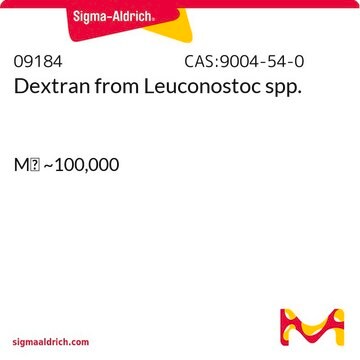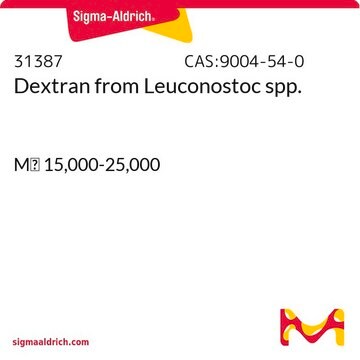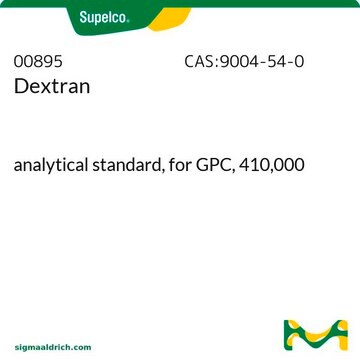31392
Dextran from Leuconostoc spp.
Mr 450,000-650,000
Synonym(s):
6-O-(6-O-beta-D-Glucopyranosyl-beta-D-glucopyranosyl)-D-glucose, Manninotriose
Select a Size
Select a Size
About This Item
Recommended Products
biological source
(Leuconostoc spp)
Quality Level
form
powder
mol wt
Mr 450,000-650,000
technique(s)
cell based assay: suitable
loss
≤7% loss on drying
color
white
mp
483 °C ((901 °F ))
solubility
water: 1.5 g/10 mL, clear, colorless
absorption
≤0.05 at 375 nm in H2O at 10%
Looking for similar products? Visit Product Comparison Guide
General description
Application
- in the isolation of human neutrophils from blood samples
- for blood sedimentation
- in the resuspension of human umbilical vein cells (HUVECs) for 3D microfluidic cellular adhesion assay
- in studying aqueous two-phase system (ATPS) droplets In microfluidic systems and biocompatible applications
- to study its mechanical properties through single-molecule force spectroscopy
Biochem/physiol Actions
- Osmotic Balance: Dextran helps maintain osmotic balance by increasing the solute concentration in a solution. This prevents excessive water movement across cell membranes, thus maintaining cell integrity and function.
- Cryoprotection: Dextran acts as a cryoprotectant by forming a protective barrier around cells and tissues during freezing. This barrier inhibits the formation of ice crystals, which can damage cell membranes and structures.
- Viscosity Control: Dextran can alter the viscosity of solutions by increasing the molecular weight of the solution. This change in viscosity affects the flow properties of the solution, making it useful for controlling the thickness of solutions in various processes.
- Drug Delivery: Modified dextran serves as a carrier for controlled drug delivery. Dextran can encapsulate drugs and release them gradually, enhancing drug solubility and controlling the release profiles to improve therapeutic outcomes.
- Gel Electrophoresis: Dextran increases the density of sample-loading solutions in gel electrophoresis. This increased density helps samples sink into the gel matrix, allowing for more precise separation of molecules based on size and charge during electrophoresis.
- Enzyme Stabilization: Dextran stabilizes enzymes by providing a protective environment. It forms a stable matrix around enzymes, enhancing their activity and extending their lifespan in various biochemical reactions. This protection prevents enzyme denaturation and inactivation, allowing enzymes to function more effectively.
Features and Benefits
- Dextran with an average molecular weight range of 450,000-650,000
- Freely soluble in Water, DMSO, formamide, ethylene glycol, and glycerol
- Versatile and adaptable for wide variety of laboratory and research applications
Other Notes
comparable product
Storage Class
11 - Combustible Solids
wgk_germany
WGK 2
ppe
Eyeshields, Gloves, type N95 (US)
Choose from one of the most recent versions:
Certificates of Analysis (COA)
Don't see the Right Version?
If you require a particular version, you can look up a specific certificate by the Lot or Batch number.
Already Own This Product?
Find documentation for the products that you have recently purchased in the Document Library.
Customers Also Viewed
Related Content
Dextrans are polysaccharides with molecular weights ≥1,000 Dalton, featuring a linear backbone of α-linked d-glucopyranosyl repeating units.
Our team of scientists has experience in all areas of research including Life Science, Material Science, Chemical Synthesis, Chromatography, Analytical and many others.
Contact Technical Service













